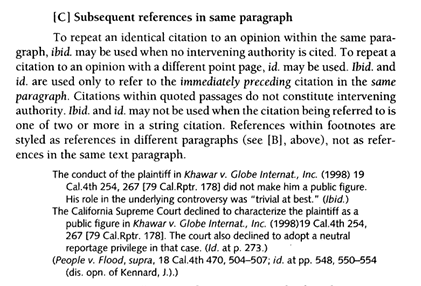Mastering legal citations demonstrates professionalism
If you’re an appellate attorney, writing accurate legal briefs is crucial, and that includes using the right citation terms. Two terms you’ll often encounter are id. and ibid.—but what’s the difference between them, and how do you use them properly?
Understanding the nuances between these two terms is essential for maintaining precision and professionalism in your briefs. In this blog post, we break down the key differences between id. and ibid. and show you how to use each term, according to the Bluebook’s rules.
What does id. mean?
Id. is short for idem, a Latin term meaning the same. In legal citations, id. is used to refer to a single source that was cited immediately before. It keeps your citations short and sweet by avoiding repetitive references to the same authority.
When to use id. in a legal brief
1. Immediate subsequent citation: Id. is used when the subsequent citation refers to the same source as the one immediately preceding it. It is a tool to maintain brevity and clarity in legal writing.
2. Page numbers: When the page number is different from the previous citation, you should include the new page number after id. (e.g., Id. at 123).
Example of using id. in citations:
First citation:
Smith v. Jones, 123 U.S. 456, 458 (2020).
Immediate subsequent citation with the same page:
Id.
Immediate subsequent citation with a different page:
Id. at 459.
According to the Bluebook, Rule 4.1, id. may be used to refer to any kind of authority, including cases, statutes, and secondary sources, as long as it is the same source as the one immediately preceding it.
What does ibid. mean?
Ibid. is an abbreviation for ibidem, another Latin term meaning in the same place. However, ibid. is rarely used in legal writing in the United States (except in California, more on that below) and is more commonly found in academic works, particularly in humanities. The Bluebook doesn’t provide specific rules for ibid. because it is generally not a preferred term in legal citations.
In legal briefs, especially those following the Bluebook guidelines, id. is the recommended term. Ibid. is less clear and can be confusing, so it’s better to stick with id. for clarity. However, it can still be helpful to understand ibid.’s usage, especially when dealing with international legal documents or academic texts.
Why id. is preferred over ibid. in legal writing
The Bluebook’s preference for id. over ibid. is rooted in the need for consistency and clarity in legal documents. Id. clearly indicates that the reference is to the same source cited immediately before, providing a streamlined and unambiguous method for citing repeated sources—that makes your citations easier to follow. Ibid. can sometimes be confusing, especially if you have multiple citations close together or in complex footnotes.
Tips for using id. in your legal brief
- Check the immediate previous reference: Always make sure id. refers to the source cited immediately before it. If there’s any interruption with a different source, don’t use id.
- Keep it clear: While id. helps avoid repetition, make sure it doesn’t create confusion. If there’s any chance of misunderstanding, it’s better to repeat the full citation.
- Be consistent: Stick to the Bluebook rules to ensure your citations are uniform throughout your brief. This shows attention to detail and adherence to professional standards.
- Multiple citations: If you’re citing multiple sources in a sentence or footnote, be careful with id. to avoid ambiguity. Sometimes, it’s clearer to repeat the full citation or use a short form citation.
Bluebook rules for using id.
The Bluebook provides comprehensive guidelines for the use of id. in Rule 4.1. Here are some key points:
- Capitalization and italics: Id. should always be italicized when used in citations.
- Page number inclusion: If the pinpoint citation (page number) changes from the previous reference, the new page number must follow id.
- Use in text and footnotes: Id. can be used in both the main text of the brief and in footnotes, following the same rules for each context.
Examples from the Bluebook:
Same page reference:
- Main text: Smith v. Jones, 123 U.S. 456, 458 (2020). Id.
- Footnote: Smith v. Jones, 123 U.S. 456, 458 (2020). Id.
Different page reference:
- Main text: Smith v. Jones, 123 U.S. 456, 458 (2020). Id. at 459.
- Footnote: Smith v. Jones, 123 U.S. 456, 458 (2020). Id. at 459.
Don’t forget to check local rules
While the basic usage is typically similar, you should always check local court rules or guidelines about how to format citations, as there might be slight variations or additional requirements specific to state courts or individual counties.
For example, there are many important differences between The California Style Manual and the Bluebook, and if you’re filing in Texas, you should be aware of some key differences between the Bluebook and Texas Greenbook.
Notably, as detailed in Cal. Style Manual, § 1:2, you can use ibid. to repeat an identical citation to an opinion within the same paragraph, when no intervening authority is cited…and it just gets more complicated from there:

Use technology to help format citations correctly
Since it can be very tricky and time-consuming to properly format citations, especially as you add, delete, or move them as you edit your brief, consider using a trusted AI-enabled brief formatting solution, such as TypeLaw, to help you get it right. That will free up your time to focus on developing and refining your argument, instead of formatting minutiae.
TypeLaw can also automatically pin-cite hyperlink your citations, which makes it easier for the court to follow, verify, and adopt your argument. Note that hyperlinked briefs are increasingly preferred by most courts—and are actually required in some jurisdictions. We’ve published a guide that details which courts require hyperlinked briefs.
Professionalism. Clarity. Simplicity.
Mastering the use of id. is a fundamental skill for appellate attorneys aiming to write precise, rule-compliant legal briefs. While ibid. has its place in other forms of writing, the Bluebook clearly supports using id. for its clarity and simplicity in legal writing.
By following the guidelines and tips outlined in this post, you can ensure that your briefs are accurate and professionally crafted, which makes them more persuasive and effective. For further details, always refer to the latest edition of the Bluebook, and any relevant local style guides, as the authoritative sources for citation practices.


